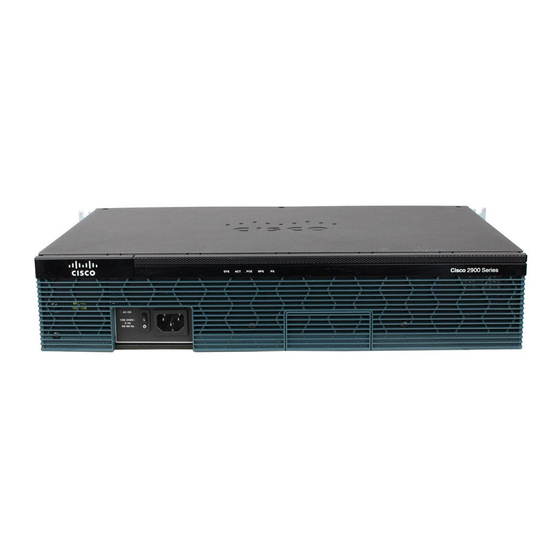Cisco 2911 Fiche technique - Page 3
Parcourez en ligne ou téléchargez le pdf Fiche technique pour {nom_de_la_catégorie} Cisco 2911. Cisco 2911 16 pages. 2900 series integrated services routers
Également pour Cisco 2911 : Manuel (10 pages)

Architectural Feature
TDM Interconnectivity Fabric
Integrated Gigabit Ethernet
Ports
Innovative Universal-Serial-
Bus (USB)-Based Console
Access
Optional Integrated Power
Supply for Distribution of PoE
and Universal DC Power
Supply
Optional External Redundant
Power Supply (RPS)
PoE Boost
Designed for Flexible
Deployments
Modularity Features and Benefits
The Cisco 2900 Series provides significantly enhanced modular capabilities (refer to Table 3) offering investment
protection for customers. Most of the modules available on previous generations of Cisco routers, such as the
Cisco 2800 Series, are supported on the Cisco 2900 Series. Additionally, modules can be used on other supported
Cisco platforms to provide maximum investment protection. Taking advantage of common interface cards across a
network greatly reduces the complexity of managing inventory requirements, implementing large network rollouts,
and maintaining configurations across a variety of branch-office sizes.
A complete list of supported modules, including a list of supported SFPs for the Cisco 2900 Series, is available at:
http://www.cisco.com/go/2900.
Table 3.
ISR Modules
Cisco Service Module
© 2013 Cisco and/or its affiliates. All rights reserved. This document is Cisco Public Information.
Benefits
● Unified communications services in the branch office are significantly enhanced with the use of a TDM
interconnectivity fabric in the system architecture, allowing for scaling of DS-0 channel capacity.
● All onboard WAN ports are 10/100/1000 Gigabit Ethernet WAN routed ports.
● One of the three 10/100/1000 Ethernet WAN ports on the Cisco 2921 and 2951 supports Small Form-
Factor Pluggable (SFP)-based connectivity in lieu of a RJ-45 port and enabling fiber connectivity.
● A new, innovative USB console port offers management connectivity for devices without a serial port such
as modern laptop computers.
● Traditional console and auxiliary ports are also available.
● An optional upgrade to the internal power supply provides inline power (802.3af-compliant PoE and Cisco
Inline Power) to integrated switch modules.
● On the Cisco 2911, 2921, and 2951, an optional DC power supply will be available in the future that
extends deployment into central offices and industrial environments.
● The Cisco 2911, 2921, and 2951 allow for power redundancy through the use of an external RPS device,
thereby decreasing network downtime and protecting the network from power-supply failures.
● Redundant power on the Cisco 2900 Series is supported through the Cisco RPS 2300 Redundant Power
System. You can use the Cisco RPS 2300 to provide redundant power for Cisco 2900 Series ISRs as well
as Cisco Catalyst
● In order to use the Cisco RPS 2300, an external RPS adapter is required (configurable option) to connect
the platform to the external RPS.
● When connected to an external RPS device, the Cisco 2911, 2921, and 2951 can operate in a PoE boost
configuration in lieu of redundant power mode - whereby the power capacity of the platform is increased to
twice the normal level to power additional PoE ports.
● The Cisco 2911 and 2951 are designed for NEBS environments.
● The 2911 is 12" deep and has an optional fan filter for deployments in a variety of environments. An
assembly that provides front-to-back airflow is also available for 23" racks.
Modularity Features and Benefits
Benefits
● Each service module slot offers high-data-throughput capability:
◦
Up to 4 Gbps aggregate toward the route processor.
◦
Up to 2 Gbps aggregate to other module slots over MGF.
● Service module (SM) slots are highly flexible with support for double-wide service modules (SM-Ds),
which are Service Modules that require two SM slots. SM-Ds in the Cisco 2921 and 2951 provide
flexibility for higher-density modules.
● A service module slot replaces the network module and the extension module for voice/fax (EVM) slots
and is offered on Cisco 2911, 2921, and 2951 ISRs.
● An adapter module enables backward compatibility with existing network modules, enhanced network
modules (NMEs), and EVMs.
● Service module slots provide twice the power capabilities relative to the network-module slots, allowing
for flexibility for higher-scale and better-performance modules.
● Power to service module slots can be managed by extensions similar to the Cisco EnergyWise
framework, so your organization can reduce energy consumption in your network infrastructure. Full
EnergyWise support will be available in future software releases.
®
switches.
Page 3 of 15
